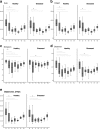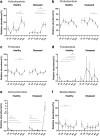Dynamic construction of gut microbiota may influence allergic diseases of infants in Southwest China
- PMID: 31182034
- PMCID: PMC6558729
- DOI: 10.1186/s12866-019-1489-4
Dynamic construction of gut microbiota may influence allergic diseases of infants in Southwest China
Abstract
Background: Gut microbes have been suggested as the possible targets in the management of allergic diseases. However, the way in which these microbes influence allergic diseases remain unclear. Forty-seven full-term newborns were selected from a 1000-infant birth cohort. Among them were 23 allergic infants, whereas 24 infants were healthy without allergic symptoms at 1 year of age. Two hundred and sixty-four fecal samples were collected at 7 time points following their birth. These fecal samples were microbiologically analyzed using 16S rRNA gene sequencing. The dynamic processes involved in gut microbiota diversity and composition in the tested infants were constructed.
Results: Healthy infants demonstrated more statistical differences in longitudinal changes in the alpha diversity of their microbiota at the time points compared with day 0 (meconium) than did allergic infants. Analysis of beta diversity showed that the fecal microbiota of days 0 and 2 comprised different communities in healthy infants, and that there were three separate communities in the fecal microbiota of day 0 of the healthy infants, those of day 2 of the healthy infants, and those of days 0-2 of the allergic infants. The relative abundance of dominant gut microbiota at phylum level varied at different time points in the healthy and diseased groups. Bifidobacterium, Escherichia-Shigella, Streptococcus, Clostridium_sensu_stricto_1, Akkermansia and Erysipelatoclostridium were significantly different between the healthy and diseased groups at a different time points.
Conclusion: The dynamic construction processes of gut microbiota during early life might be associated with the occurrence of long-term allergic diseases, with the first month following birth potentially being the most critical.
Keywords: Allergic diseases; Dynamic process; Gastrointestinal microbiome; High-throughput nucleotide sequencing; Infant; RNA,Ribosomal,16S.
Conflict of interest statement
The authors declare that they have no competing interests.
Figures





Similar articles
-
Gut microbiota shifts in patients with gastric cancer in perioperative period.Medicine (Baltimore). 2019 Aug;98(35):e16626. doi: 10.1097/MD.0000000000016626. Medicine (Baltimore). 2019. PMID: 31464899 Free PMC article.
-
The development of gut microbiota in critically ill extremely low birth weight infants assessed with 16S rRNA gene based sequencing.Gut Microbes. 2014 May-Jun;5(3):304-12. doi: 10.4161/gmic.28849. Gut Microbes. 2014. PMID: 25184833 Free PMC article.
-
Changes in Gut Microbiota at 1-60 Days in 92 Preterm Infants in a Neonatal Intensive Care Unit Using 16S rRNA Gene Sequencing.Med Sci Monit. 2023 Nov 29;29:e941560. doi: 10.12659/MSM.941560. Med Sci Monit. 2023. PMID: 38018034 Free PMC article.
-
Gut Microbiota Profile in Patients with Type 1 Diabetes Based on 16S rRNA Gene Sequencing: A Systematic Review.Dis Markers. 2020 Aug 27;2020:3936247. doi: 10.1155/2020/3936247. eCollection 2020. Dis Markers. 2020. PMID: 32908614 Free PMC article.
-
The Effect of COVID-19 Pandemic on the Infants' Microbiota and the Probability of Development of Allergic and Autoimmune Diseases.Int Arch Allergy Immunol. 2022;183(4):435-442. doi: 10.1159/000520510. Epub 2021 Dec 3. Int Arch Allergy Immunol. 2022. PMID: 34864741 Free PMC article. Review.
Cited by
-
The gut microbiota is associated with the small intestinal paracellular permeability and the development of the immune system in healthy children during the first two years of life.J Transl Med. 2021 Apr 28;19(1):177. doi: 10.1186/s12967-021-02839-w. J Transl Med. 2021. PMID: 33910577 Free PMC article.
-
Development of gut microbiota and bifidobacterial communities of neonates in the first 6 weeks and their inheritance from mother.Gut Microbes. 2021 Jan-Dec;13(1):1-13. doi: 10.1080/19490976.2021.1908100. Gut Microbes. 2021. PMID: 33847206 Free PMC article.
-
The First 1000 Days of Life: How Changes in the Microbiota Can Influence Food Allergy Onset in Children.Nutrients. 2023 Sep 16;15(18):4014. doi: 10.3390/nu15184014. Nutrients. 2023. PMID: 37764797 Free PMC article. Review.
-
Dysbiosis of intestinal microbiota in early life aggravates high-fat diet induced dysmetabolism in adult mice.BMC Microbiol. 2021 Jul 8;21(1):209. doi: 10.1186/s12866-021-02263-6. BMC Microbiol. 2021. PMID: 34238228 Free PMC article.
-
Staphylococcus epidermidis SAS1: new probiotic candidate for obesity and allergy treatment their mechanistic insights and cytotoxicity evaluation.Front Microbiol. 2025 Apr 30;16:1546687. doi: 10.3389/fmicb.2025.1546687. eCollection 2025. Front Microbiol. 2025. PMID: 40371109 Free PMC article.
References
-
- NCGOC, Asthma Third nationwide survey of childhood asthma in urban areas of China. Zhonghua Er Ke Za Zhi [Chin J Pediatr] 2013;51:729–735. - PubMed
-
- Mei F, Yizhu X, Yan H. Analysis of environmental factors affecting infantile eczema in different genetic backgrounds. Zhongguo Ertong Baojian Za Zhi [Chin J Child Health Care] 2015;23:1070–1073.
-
- Wa D, Yuan Z, Luo Z. Natural processes and interventions for allergic diseases. Shoudu Yike Daxue Xuebao [J Cap Med Univ] 2011;32:55–59.
Publication types
MeSH terms
Substances
LinkOut - more resources
Full Text Sources
Medical

